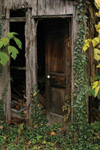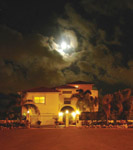 |
|
|||||||
|
Features
Think Like a Pro No doubt about it, serious photography is difficult because it requires both a mastery of technique and an eye for esthetics. Sometimes one gets in the way of the other and visual chaos results. But if you think like a professional photographer, youâll find it a lot easier to get the kinds of results thatâll have both you and your ăclientsä saying: ăThatâs a great shot!ä Letâs begin. 01 Have a goal in mind whenever you decide to shoot pictures. Donât just wander around hoping that something will catch your eye. Decide, for example, that todayâs the day for shooting unique doorways, or seals at the zoo, or something equally specific. With your mind (and eye) focused on one objective, you wonât get frustrated trying to find things to take pictures of or come back with a lot of junk. In essence, you are taking on an ăassignmentä that has some structure to it and you will be forced to shoot accordingly. Youâll also end up with lots of good pictures to choose from instead of a smorgasbord of images, none of which may be very good because you didnât spend enough time on each of them. 02 If you want to shoot great candid pictures of kids, pretend to ignore them. With younger kids, be pleasant at first but if they continue to bug you with questions or start to ham it up for the camera just donât answer and keep the camera up to your eye. Theyâll quickly become bored and go back to their activities, forgetting that youâre there (which is exactly what you want). Dealing with pre-teens and teens requires negotiation, especially if you want them to pose for some portraits. Tell them up front you know this may not be their idea of fun but you promise it wonât take more than 15 minutes. Most of them can live with that, though theyâll probably still think itâs an eternity. If you offer a reward, that will sweeten the deal considerably.
04 Find a long-term project to work on. You wouldnât think it, but most pros have a pet project theyâre working on aside from their commercial assignments. Though it sounds like a busmanâs holiday, it keeps their eye in shape and allows them to shoot whatever (and however) they want without having to answer to a client. Committing to a long-term project also will allow you to make adjustments as you move along. As you shoot and see your results, you begin to think about how certain images could be improved and you can then make a mental note of what to do the next time out. To begin with, pick a subject that you can spend at least a half-day a week with over a one or two month period. This could be a bridge or building shot from different viewpoints at different times of day, or a sports or singing group that meets periodically, or a series of pictures on almost any subject. 05 Stop counting pennies (actually dollars). When film was in its heyday, film and processing were expensive. If you did your own darkroom work, paper and chemicals added to the cost. Hereâs something all pros learned early on: if you wanted to get good, you had to shoot a lot of film and if you did your own developing and printing, you couldnât count pennies when it came to making half a dozen or more prints of the same image to get one that was perfect. You just had to forget the price or youâd stop shooting or printing too soon. The easiest way to do that was to buy 100 rolls of film at a time and 500-sheet boxes of paper so you could just dip into an endless supply. Today, as a digital photographer, you donât spend a cent on film or processing so youâre way ahead. Put that money toward buying a dozen or more inksets and a few hundred sheets of paper÷all at once÷so you can work on an image until it reaches perfection without thinking about running out of supplies or how much it costs.
07 There are things you should always have with you÷extra memory cards, batteries, a tripod and all that, but most pros have a much longer list and it goes beyond throwing an iPod into their camera bag for entertainment. One of the most valuable pieces of gear you can have is a pair of kneepads (do I hear some snickering, out there?). Most photographers simply duck-squat when trying to shoot dramatic low-angle shots and that can just about wreck your body. An inexpensive pair of knee-pads from Home Depot can let you get down and dirty with a smile on your face. You can even wear them under an old pair of jeans so youâre ready to hit the ground at any time. For less extreme shots, bring along a lightweight folding canvas stool (about 13-inches high) so you can sit low and shoot, say, at the sidelines of an event. And at the other end of the spectrum, most pros carry a small ladder for times they need a little added height to improve their viewpoint. 08 Force yourself to shoot the same subject from different points of view and at different times of day. At first, this can be a killer because it takes some thinking and a lot of work. But if you look at images shot by pros, youâll find that most of them have been shot at an unusual angle or with unusual lighting (early or late in the day or at night). Pros have to bring back eye-poppers and shooting the subject straight on at noon just doesnât cut it. After awhile, it will just become natural for you to think in terms of different angles and lighting and your pictures will suddenly begin to jump out at viewers. Pros also love wide angle lenses because they give a unique look to an image and can add some deliberate distortion. Buy a wide-angle lens and learn to love it, too.
10 One of the most difficult things photographers have to learn is to overcome their reluctance to approach people they donât know and ask if they can photograph them. A pro once told me how he was able to establish quick rapport with subjects, putting them at ease while he shot their pictures. He said he always had an imaginary aunt, uncle, nephew, or niece in his pocket who was in the same occupation as his intended subject. For example, if he was photographing oil workers on a rig, heâd tell them how his ăuncleä used to work on oil rigs and how his ăauntä was always complaining because, even though the money was good, she and the family didnât see him for weeks at a time. He would immediately see nods and smiles and the ice was broken. OK, maybe you think he was cheating a bit but it worked and no one was hurt by it. If you use this technique, remember not to have an immediate member of your family in the same occupation or you may be expected to know more than you do. 11 Props can make or break a shot. Many pros drag a whole bunch of them along if they are appropriate to their assignment. A little girl is just a little girl, but a little girl with a red balloon can really catch your eye. Scenic photographers frequently carry a duffel bag full of different colored jackets and hats for their foreground subjects to wear so they stand out. If you shoot pictures of kids and teens, encourage them to bring along their favorite toys or possessions; itâll make the shot more interesting and your subjects will be more comfortable in front of the camera.
13 There are a few things you shouldnât do. One of them is relying on your sequence (or burst) mode to catch a great action shot. Shooting a sequence of images doesnât guarantee youâll catch the peak of action; the only way thatâd be a shoo-in is if your camera could fire at about 30 frames or more per second and thatâs not possible yet. Besides, even if it were, think of the memory card requirements. Before motor drives became available on film cameras, sports photographers relied on their own sense of timing to stop the action. Guess what? They did a pretty good job of it. All it takes is practice. The other thing you should avoid is being too quick to erase ăbadä images. Many pros have gone through their film negatives after the passage of time and have found great images they overlooked when they first shot them. Digital makes it too easy to make quick (and often wrong) decisions to delete pictures. Only scrub obvious garbage÷if youâre not sure, keep it. 14 Imaging programs will not improve your photographic skills. This may sound like digital heresy but slavish devotion to these programs can impede your progress as a photographer. When film was king, many of the worldâs greatest photographers never went near a darkroom÷they handed their ătakeä to a lab for processing and then edited their slides. Imaging programs are great for adjusting brightness, contrast, color, sharpness, and for getting rid of imperfections and unwanted elements but thatâs all you need to know how to do. If you spend a lot of time with your imaging program, thatâs less time to shoot. The secret is to shoot correctly to begin with so the time you spend on the computer is minimized. And spending US $650 for Photoshop when $80 for Elements will suffice is simply an exercise in conspicuous consumption or keeping up with the Jonesâs, both of which are despicable
|
|||||||
|
|
|||||||
|
©
2004 D.C. Publications, Inc. All Rights Reserved. |
|||||||


 Professional
photographers usually take better photos than you do because, a)
they shoot more and, b) they have developed methods to assure that
knock-out pictures are delivered to their clients. You, too, have
clients (family and friends) and although they may not be as demanding
(because theyâre not paying) you still have an obligation (and hopefully
a desire) not to bore them with trivial snapshots.
Professional
photographers usually take better photos than you do because, a)
they shoot more and, b) they have developed methods to assure that
knock-out pictures are delivered to their clients. You, too, have
clients (family and friends) and although they may not be as demanding
(because theyâre not paying) you still have an obligation (and hopefully
a desire) not to bore them with trivial snapshots.  03
Donât fixate on equipment. Many photographers constantly gripe that
if only they had this or that camera or lens, they could make better
pictures. That really applies to only a few areas, mainly sports
and wildlife where, indeed, some long telephoto lenses are required.
But you know what? Even if these complainers had those lenses, theyâd
find another reason why they couldnât bring home the bacon. Learn
to make the most of the equipment you have and you may find you
donât really need as much as you thought you would. Unless they
have assistants along, most pros leave the kitchen sink at home
and travel lightö a couple of camera bodies and a few lenses. The
legendary Henri Cartier-Bresson shot most of his great pictures
with one camera and a 50mm lens.
03
Donât fixate on equipment. Many photographers constantly gripe that
if only they had this or that camera or lens, they could make better
pictures. That really applies to only a few areas, mainly sports
and wildlife where, indeed, some long telephoto lenses are required.
But you know what? Even if these complainers had those lenses, theyâd
find another reason why they couldnât bring home the bacon. Learn
to make the most of the equipment you have and you may find you
donât really need as much as you thought you would. Unless they
have assistants along, most pros leave the kitchen sink at home
and travel lightö a couple of camera bodies and a few lenses. The
legendary Henri Cartier-Bresson shot most of his great pictures
with one camera and a 50mm lens.  06
ăPreparation, preparation, preparation.ä That was the late Johnny
Cochran Jr.âs mantra and youâd do well to heed it. When pros get
assignments, they donât just throw their camera gear in a bag and
take off. In the early stages of my career, I sat next to a National
Geographic photographer on a plane to Alaska and watched as he went
through notebooks worth of material he had researched for weeks
before leaving on his assignment. Years later, I found myself doing
the same thing because itâs the only way to make sure you have all
your bases covered and know what to look for. Now, with the Internet
so easily accessible, thereâs just no excuse for not learning everything
you can about your intended subject so you know what to look for
before you even turn your camera on.
06
ăPreparation, preparation, preparation.ä That was the late Johnny
Cochran Jr.âs mantra and youâd do well to heed it. When pros get
assignments, they donât just throw their camera gear in a bag and
take off. In the early stages of my career, I sat next to a National
Geographic photographer on a plane to Alaska and watched as he went
through notebooks worth of material he had researched for weeks
before leaving on his assignment. Years later, I found myself doing
the same thing because itâs the only way to make sure you have all
your bases covered and know what to look for. Now, with the Internet
so easily accessible, thereâs just no excuse for not learning everything
you can about your intended subject so you know what to look for
before you even turn your camera on.  09
Pros read many of the same books and magazines about photography
that you do and listen to a lot of chatter about which cameras,
lenses, printers, computers, and software are supposed to be the
best. But they donât go switching around wildly because that can
lead to disaster. If you find that the camera and lens(es) you have
are giving you good results, stick with them. If shooting in JPEG
yields good prints, thereâs no need to get bogged down in RAW. Some
photographers actually like to use complicated processes÷it makes
them feel superior to others. You donât need the latest and greatest
to make good pictures; constantly changing your gear and techniques
may actually hold you back as you constantly struggle with new learning
curves. Most pros keep things simple so they can concentrate on
the image-making process. You should, too.
09
Pros read many of the same books and magazines about photography
that you do and listen to a lot of chatter about which cameras,
lenses, printers, computers, and software are supposed to be the
best. But they donât go switching around wildly because that can
lead to disaster. If you find that the camera and lens(es) you have
are giving you good results, stick with them. If shooting in JPEG
yields good prints, thereâs no need to get bogged down in RAW. Some
photographers actually like to use complicated processes÷it makes
them feel superior to others. You donât need the latest and greatest
to make good pictures; constantly changing your gear and techniques
may actually hold you back as you constantly struggle with new learning
curves. Most pros keep things simple so they can concentrate on
the image-making process. You should, too.  12
Always keep your eyes open for picture possibilities that are not
mainstream. For example, I know a sports photographer whose most
interesting shots are not of the game but of things big and small
that surround it. In the world of motion pictures these are known
as cutaways, scenes related to the main action but not part of it.
Fans in the stands, players in anguish over losing or triumphant
in victory, a referee tying his shoelaces, bored pitchers in the
bullpen, and so on. Similarly, everyday things that you walk by
a thousand times bear closer examination. A rope tied to a pole
can make a great design shot if you move in on it and frame it well.
Even a water sprinkler head can look like a museum piece if you
take the time to shoot it at a unique angle when the light is right.
12
Always keep your eyes open for picture possibilities that are not
mainstream. For example, I know a sports photographer whose most
interesting shots are not of the game but of things big and small
that surround it. In the world of motion pictures these are known
as cutaways, scenes related to the main action but not part of it.
Fans in the stands, players in anguish over losing or triumphant
in victory, a referee tying his shoelaces, bored pitchers in the
bullpen, and so on. Similarly, everyday things that you walk by
a thousand times bear closer examination. A rope tied to a pole
can make a great design shot if you move in on it and frame it well.
Even a water sprinkler head can look like a museum piece if you
take the time to shoot it at a unique angle when the light is right.
 15
Pros frequently donate their time to charitable projects and so
should you. It will give you a good feeling to know just how powerful
photography can be as a force for positive change. And you will
make a lot of contacts that can be valuable to you in the future.
The State of New Jersey recently asked top pros (like David Bergman
whoâs been featured in DCM) if they would photograph kids who were
up for adoption. They wanted appealing images that would give an
insight into the kidsâ personalities rather than just mug shots
that theyâd used in the past. As a result, more kids were adopted
and each photographer came away profoundly touched by the experience.
You can see the results at The Heart Gallery
15
Pros frequently donate their time to charitable projects and so
should you. It will give you a good feeling to know just how powerful
photography can be as a force for positive change. And you will
make a lot of contacts that can be valuable to you in the future.
The State of New Jersey recently asked top pros (like David Bergman
whoâs been featured in DCM) if they would photograph kids who were
up for adoption. They wanted appealing images that would give an
insight into the kidsâ personalities rather than just mug shots
that theyâd used in the past. As a result, more kids were adopted
and each photographer came away profoundly touched by the experience.
You can see the results at The Heart Gallery